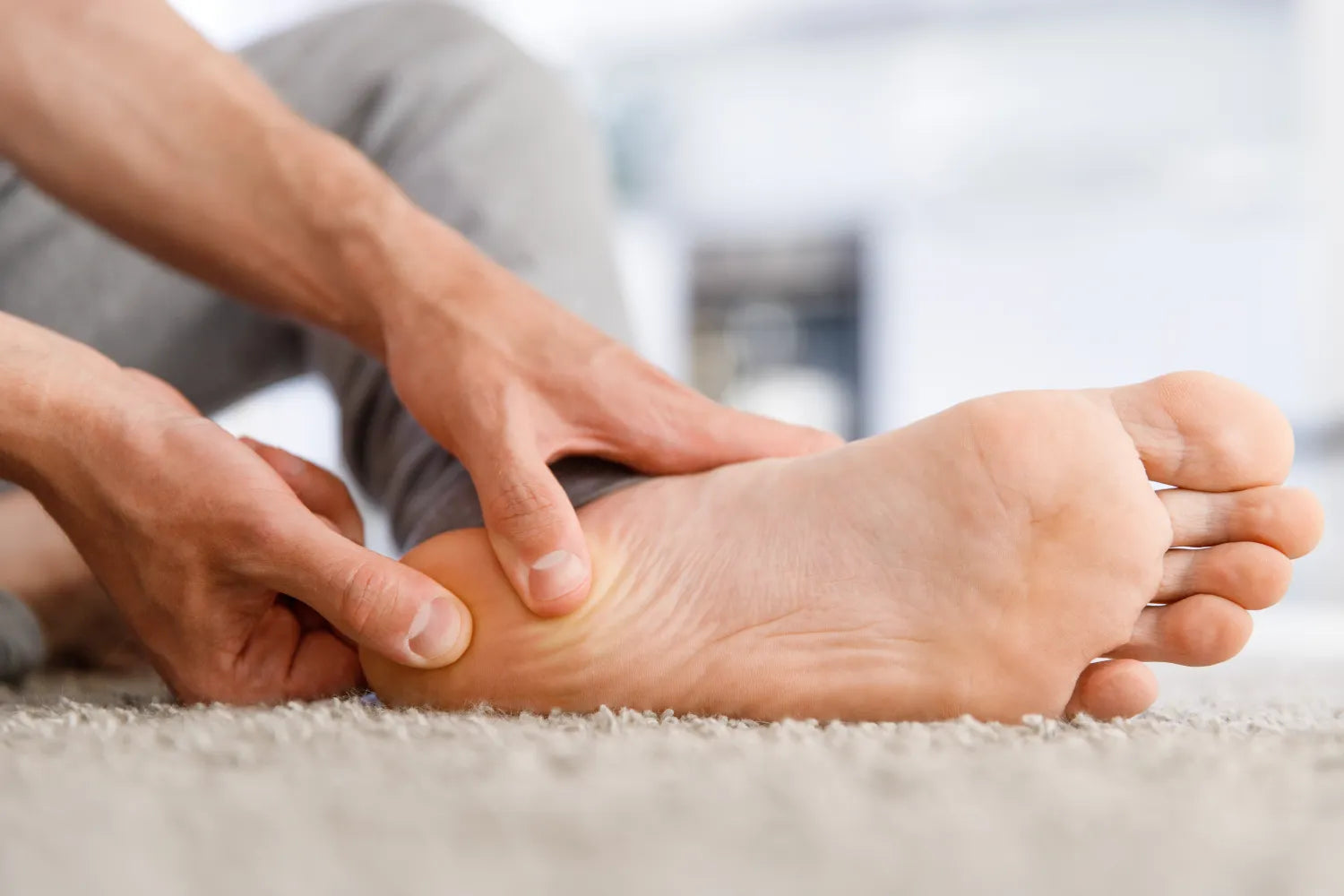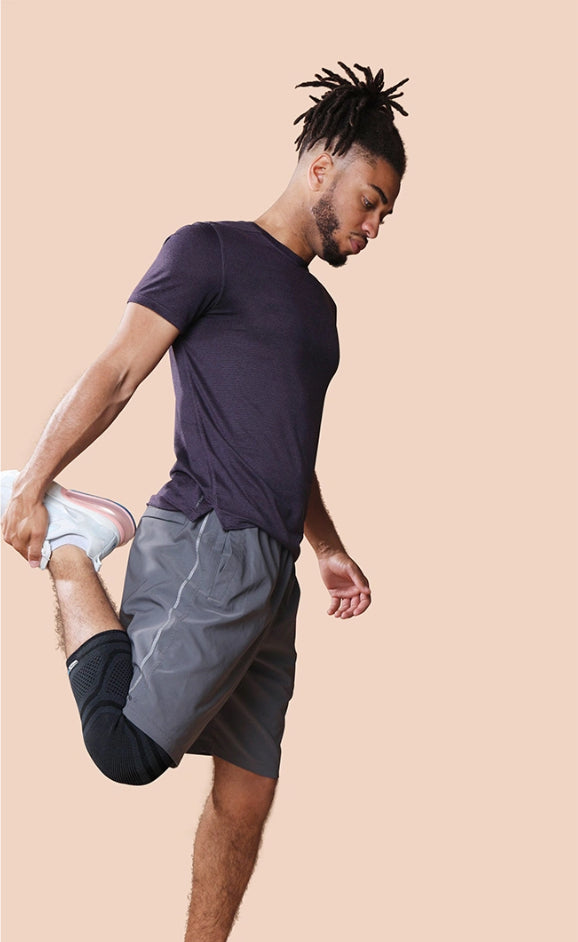
Plantar fasciitis can be a real roadblock on your journey to staying active and healthy. This common cause of heel discomfort affects countless people, hindering their ability to move freely and often leading to a cycle of tension and longer recovery periods.
Don't worry; a variety of solutions can support your body's natural abilities in managing this discomfort. One such solution is compression socks.
So, let's jump right in and start unraveling the mystery of plantar fasciitis and how socks can play a role in managing it.
What Is Plantar Fasciitis?
Plantar fasciitis is a common source of heel discomfort that can affect anyone but is particularly prevalent among athletes and active adults. It occurs when the plantar fascia, the thick band of tissue that runs across the bottom of your foot and connects your heel bone to your toes, gets inflamed.
This irritation can cause a stabbing discomfort that is usually worse with the first steps in the morning or after long periods of standing or sitting. As you get up and move more, the discomfort might decrease, but it can return after prolonged periods of standing or when you stand up after sitting.
What Can Cause Plantar Fasciitis?
Plantar fasciitis is often the result of strain injuries that cause micro-tears to the ligament as it attaches to the heel bone or other areas of the foot. Factors that can increase your risk include age, certain types of exercise (like long-distance running), being overweight, and spending a lot of time on your feet.
The discomfort from plantar fasciitis can affect your daily life and performance. It can make standing for long periods, walking, running, or even just getting out of bed in the morning a painful task. But remember, it's not something you have to live with.
There are solutions out there designed to help soothe this discomfort and support your body's recovery process. One of these solutions is the use of specially designed socks for foot discomfort.
What Are Compression Socks?
Compression socks are designed with a simple but powerful goal: to support healthy blood flow. These socks apply a certain amount of pressure to your legs and feet, which can help maintain blood flow and soothe discomfort and swelling.
The key to their benefits lies in the graduated compression they apply. This means the compression is strongest at the ankle and gradually lessens as it goes up the leg. This design encourages blood to flow back up toward your heart rather than pooling in your lower legs.
Healthy blood flow is vital for delivering oxygen and nutrients to your muscles. It's also crucial for carrying away waste products like lactic acid, which can build up during exercise and contribute to muscle soreness.
By supporting healthy blood flow, compression socks can help your body do what it naturally does, just a bit more efficiently.
Can Compression Socks Help With Foot Discomfort?
Now, onto the big question: can compression socks help with plantar fasciitis? The short answer is yes! Compression socks can be a useful tool in managing foot discomfort and tension of any kind.
Healthy blood flow is crucial for individuals dealing with plantar fasciitis. Compression socks can help carry needed nutrients and oxygen to the plantar fascia by supporting blood flow, helping ease discomfort.
Compression socks can also help support muscle relaxation. When your muscles are relaxed and not in a state of tension, they can recover more effectively. This can be particularly helpful for those dealing with plantar fasciitis, as the condition often causes tension and discomfort in the foot muscles.
In addition to compression, some socks for plantar fasciitis come with additional features like targeted cushioning and added arch support. These features can provide extra comfort and support to the areas most affected by plantar fasciitis.
What Are the Benefits of Using Compression Socks for Plantar Fasciitis?
Compression socks can be a game-changer when managing the discomfort and tension associated with plantar fasciitis.
Here's how they can help:
- Comfort: The compression in these socks can help soothe the discomfort of plantar fasciitis by supporting healthy blood flow and muscle relaxation. They provide a gentle squeeze that maintains circulation, helping to bring much-needed nutrients and oxygen to your tired feet.
- Support: Compression socks can provide targeted support to the areas of your foot most affected by plantar fasciitis, helping to soothe tension and support your foot's natural structure. This targeted support can help maintain the proper alignment of your foot, reducing the strain on your plantar fascia.
- Mobility: By easing discomfort and supporting your foot, compression socks can help your mobility. You can focus on your activities, whether it's a brisk walk in the park or a full workout session at the gym.
How To Choose the Right Socks for Plantar Fasciitis
When it comes to choosing the right socks for plantar fasciitis, it's important to find ones that provide the support you need. Start by considering the material.
Breathable, moisture-wicking materials are a great choice, as they keep your feet dry and comfortable. The level of compression is another key factor.
Compression levels can vary, so choosing socks that provide the level of compression that works best for you is essential. The socks should fit snugly but not too tightly, offering support without restricting your movement.
Finally, consider socks that offer additional features, such as targeted cushioning or arch support. These enhancements can provide extra relief and comfort for individuals dealing with plantar fasciitis.
Remember, everyone's body is different, and what works for one person might not work for another. It's always a good idea to try different solutions and see what works best for you.
How Else Can You Ease Discomfort Associated With Plantar Fasciitis?
While compression socks can be a great tool in your arsenal, there are other ways to ease the discomfort associated with plantar fasciitis:
- Regular Stretching: Stretching your foot and calf muscles can help reduce tension and promote flexibility. Try to incorporate foot stretches into your daily routine.
- Wear Supportive Footwear: Choose shoes that provide good arch support and cushioning. Avoid going barefoot, which can put additional strain on your plantar fascia.
- Maintain a Healthy Weight: Carrying extra weight can put more pressure on your plantar fascia. Maintaining a healthy weight can help alleviate this pressure.
- Rest and Ice: Giving your foot some rest and applying cold therapy can help reduce swelling and discomfort.
- Physical Therapy: A physical therapist can provide you with a set of exercises to strengthen your lower leg muscles, which can help stabilize your walk and lessen the workload on your plantar fascia.
Each of these strategies can contribute to a comprehensive approach to managing plantar fasciitis. By finding the right combination of these methods, you can help ease discomfort and support your foot's health and well-being.
The Bottom Line
Plantar fasciitis can be a hurdle on your path to staying active and fit. But with the right tools and strategies, you can manage the discomfort and continue to live an active lifestyle.
Compression socks, with their ability to support healthy blood flow and muscle relaxation, can be a valuable tool in easing the discomfort of plantar fasciitis. While they are not a cure, they can offer significant relief and support your body's natural recovery process.
In addition to compression socks, regular stretching, supportive footwear, maintaining a healthy weight, and rest and ice can all help manage plantar fasciitis discomfort. Remember to always consult a healthcare professional before starting any new treatment.
So, don't let plantar fasciitis keep you on the sidelines. Explore various solutions, find what works best for you, and continue on your journey to stay active, feel better, and enjoy life every day.
If you're ready to explore the benefits of compression, check out our blog for more information about supporting your body’s natural healing process. We're here to support your journey to comfort and performance.
Sources:
Plantar fasciitis - Symptoms and causes | Mayo Clinic
Compression Therapy | UPMC Heart and Vascular Institute
Lactic acid test Information | Mount Sinai
Best Shoes for Plantar Fasciitis According to Podiatrists | TIME





